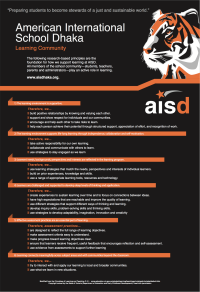One indicator I always use to evaluate professional learning is; “did it make me think or change my stance in any way?” The Feedback for Effective Thinking conference in Nanjing certainly did this for me, days later I still have ideas resonating in my brain. So, using the 8 cultural forces of thinking, I will attempt to convey a synthesis of some of my thoughts from the conference:
Time – Probably the most common reason we cite for not being the teacher we want to be. We tend to make time for the things we value, but do we always make time for what counts? For example how often do we make time for mistakes in learning? Judy Willis presented convincing evidence that visualised the areas of the brain activated when learners review and work with their mistakes, compared to when they work on tasks of knowledge recall alone. This reinforces the importance of having effective feedback systems that allow students to act on feedback.
Opportunities: Creating opportunities for thinking is central to the development of higher levels of learning. Supporting this with brain research, Judy Willis evidenced the importance of learners forming generalisations about their learning, which gives support to curriculums like the PYP, that are framed around conceptual understandings. As Ron Richhart stated, “Learning involves uncovering complexity and delving deeper.”
Routines & Structures: Using a quote from Vygotsky “children grow into the intellectual life around them,” Ron Richhart presented the power of visible thinking routines in the classroom. He stressed the routines have to be used purposefully and not just as an activity, in this respect they make excellent formative assessment strategies and can be used as a good bridge to summative assessment tasks. On the subject of questioning Dylan Wiliam proposed that both open and closed questions have their place in learning, more important is how and when we use them. For example, a powerful statement can be just as effective as an open-ended question in promoting discussion and engagement.
Modelling: We are all familiar with the strategy of modelling, it is an ancient technique amongst educators to tell the learner how to do something. However, articulating our thinking when we teach is not as common place. Importantly the language of modelling our thinking is not absolute, it is conditional and allows for other possibilities to emerge. Modelling thinking can be extremely supportive for encouraging students’ creative thought process’.
Language: Ron Richhart touched upon the importance of language use and the intended and unintended messages our discourse might convey. For example, the simple use of pronouns can be profoundly subtle in the way they communicate a sense of inclusion and collective endeavour (we / us) verses a sense of division (I / you). Both Dylan Wiliam and Ron Richhart made reference to the use of questioning in the classroom, and how we orchestrate it. For example, I imagine all teachers have experienced the students who always have their hands up and can be relied upon for positive contributions. However, allowing the stronger students to dominate can convey a sense that it is OK not to contribute to discussions and therefore it is OK to get away without thinking.
Interactions & Relationships: For me this cultural force underpins so much of what happens in successful learning because it shapes the socio/emotional development of the learner. All three presenters made reference to the important concept of fixed vs growth mindsets (Dweck, 2000). In a thinking classroom, there is little place for praising egos and well-being. Motivation comes from growth. So a dimension of learning that has a significant impact on developing a growth mindset is feedback. Dylan Wiliam did a great job of unraveling this complex dimension of learning by asking “what kind of behaviours do we encourage through our feedback?” He suggested the best feedback is “negative” because it is more specific and actionable, grades and praise can inflate the ego. Oral vs written feedback is not important, moreover it is about the salient opportunity to correct errors. “Good feedback leaves the learning with the learner.” Ultimately, we need to look for the indicators that feedback is having an impact on the learner and not on performance alone. Dylan did add that, to be most effective feedback needs to be part of a wider systems approach to formative assessment.
Good teachers know the centrality of healthy interactions and relationships, they educate the “whole person,” therefore a curriculum defined through both experience and outcomes is more powerful than one based on outcomes alone.
Physical Environment: The learning environment can transmit a lot about how thinking is valued. Ron Richhart stressed the importance of making student thinking visible, not only is this healthy for building a learning community, but it also transmits valuable information about learners’ growth.
Expectations: For me this is almost inseparable from interactions and relationships, because having challenging expectations for learners is linked partly to intrinsic motivation. Simple expectations around participation during routines can be relayed through applying strategies like “wait time,” “no hands up.” Going further, expectations can have far reaching effects on student motivation. Citing a study from positive psychology (Csicszentmihalyi, 1997), Dylan Wiliam, indicated low skill sets and low challenge is likely to result in learner boredom and apathy. We need to aim for the right balance of challenge and expectation that is tailored to the needs of the learner. The concept of “flow” (being engrossed in the moment) could be a very interesting area of learning to explore. The use of thinking strategies, feedback and good systems of formative assessment can play a big role in ensuring our students are motivated to learn.
Ron Ritchhart Website
Cultures of Thinking Resources
Project Zero Website – The Harvard Graduate School of Education
Dylan Wiliam Website
The Six Secrets of a Happy Classroom – The Independent
Judy Willis Website
Judy Willis on the Science of Learning Video – Edutopia

